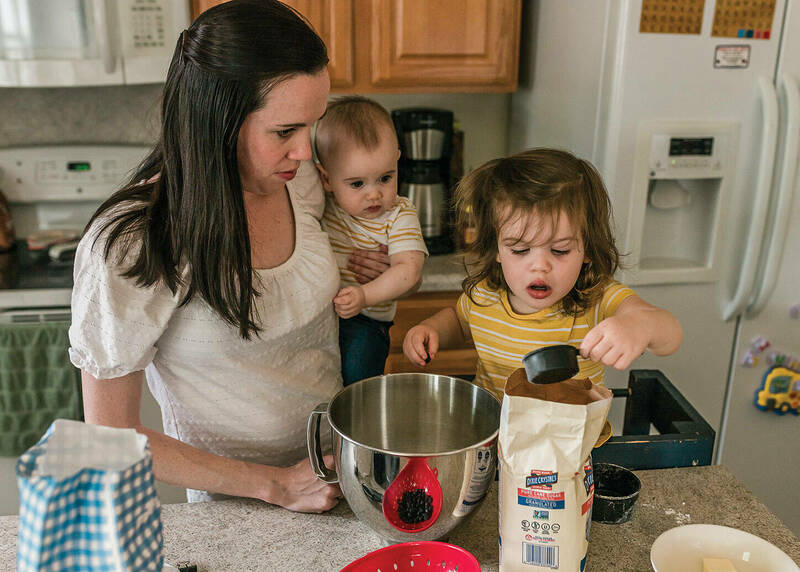 The author, not writing. Photo by Samantha Lusk
The author, not writing. Photo by Samantha Lusk
It’s a typical Wednesday morning. The sitter is downstairs with my toddler daughter, rolling a singing bus around the wood floor. The baby is nursing in my lap while I copy edit with my free hand. I have dinner simmering in the crockpot, and I’m listening for the ding of the washing machine so I can move the load of soiled kiddie sheets to the dryer so I can put a clean one on the crib before my daughter goes down for her nap.
I’ve done all this by 10 a.m., and yet I sit here working but feeling guilty. So, during a quick break, I find an activity on Pinterest to do with my daughter this afternoon after I log off. I’ve got some stickers and construction paper for a color-matching activity, and I mentally pencil that into our schedule.
Then a last-minute Zoom call gets added to my calendar. That’s fine; I turn on Frozen for the toddler and bounce the baby in his seat with my foot while I take the call. But when I hang up, I’m feeling even more guilty about my lack of momming, so I offer to bake cookies with my daughter. She loves it, but now there is flour sprinkled on the floor, dirty measuring cups and mixing bowls in the sink, and she is vacuuming up stray chocolate chips with her mouth while whining she’s ready for dinner.
Dinner routine. Clean up. Bedtime routine. At 9 p.m., both kids are tucked into bed and I’m curled on the couch, exhausted and feeling like I’ve underperformed as a mom and a working professional.
My “mom guilt” isn’t unique, says Abigail Ocobock, an assistant professor of sociology and gender studies at Notre Dame. In fact, it’s all but guaranteed in American mothers, she says.
“We know from the research that American mothers struggle with work-life balance more than moms in many other Western countries. We know that they’re already feeling really guilty. We know that they’re really struggling to balance work and parenting,” she explains, citing issues like the lack of mandatory paid leave for new parents, longer working hours, high employer expectations and weak family policies as salient contributors. She also notes something called “intensive mothering,” a commonly accepted narrative, particularly in America, that mothers are meant to sacrifice all else to nurture their children. American mothers are also less inclined to look to the government or their partners for a fix, and tend instead to direct blame inward for any work-life imbalances.
As Ocobock notes, guilt is often triggered by comparison, so just a few minutes of scrolling through the social-media feeds of crafty moms who offer activities for each holiday, chef-moms who cut fruit into hearts and bunnies, and organizational- expert moms who color-code their detailed day planners according to child can cause a deluge of shame and inadequacy.
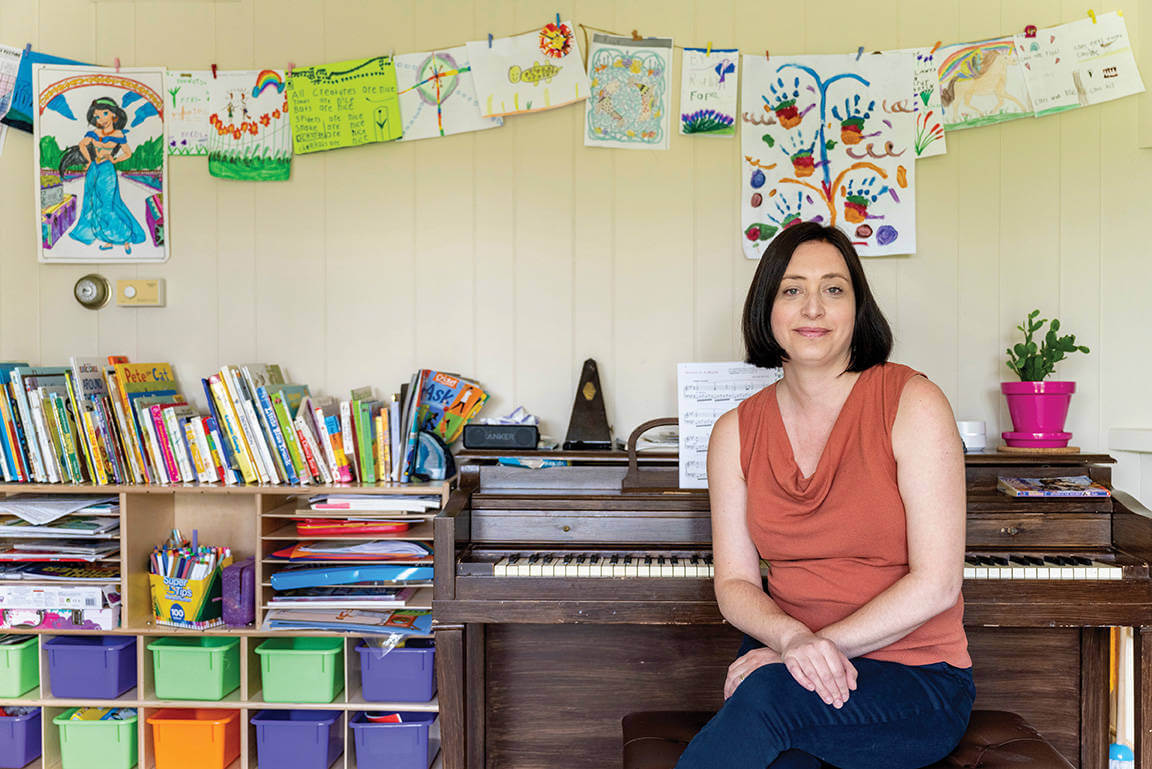
Mothering in the time of quarantine
While this prevalence of mom guilt was an issue before 2020, when the coronavirus pandemic hit and parents started working from home, Ocobock wondered whether the customary guilt would be mitigated or traditional gender roles would shift. Theoretically, she said, the pandemic and all its built-in family togetherness could have helped working mothers who struggle with the guilt of being away from their children.
She put out a call through Facebook parenting groups for full-time working parents who had at least one e-learning child in elementary or middle school. Within 48 hours she gathered over 500 volunteers, which she narrowed down to a geographically and socioeconomically diverse group of 80, to be interviewed about how they were navigating work and parenthood during the pandemic. The results suggested the mom guilt had multiplied.
“What [many moms] told me is, if you’re at home full-time with your kids, you don’t get any break from feeling guilty. You’re constantly guilty for every second that you’re not focused on them, for every time you’re working instead of helping them with their schoolwork, for every time that you do anything for yourself like check Facebook, call a friend, go and work out, whatever it is, so the guilt actually was really sort of ramped up.”
Jenna Palumbo ’10, ’12MBA has a 2-year old son, Milo, and is expecting a second child this summer. She’s also the director of financial reporting and automation at Capital One and has been working remotely since March 2020. At first, losing her commute allowed her to study for and pass her CPA exams. But in April, her son’s nanny decided she no longer felt comfortable leaving her own house and chose to stop working. The Palumbos, like many dual-career couples, opted to work in shifts. Jenna would watch Milo in the morning, and her husband, Soeren ’11, would take him in the afternoon. That’s when the guilt set in.
During Jenna’s shift, she found she was often plopping Milo in front of the television to take calls, but Soeren was able to sign off during his shift so he could take Milo to the park before resuming work in the evening. Even after hours, Jenna found she was tied to her phone and working. The line between her professional life and home life was gone.
“It’s effectively living 90 percent of both all the time,” she says. “I didn’t expect to feel so mentally and emotionally drained at the end of the day.”
When the situation became untenable, the Palumbos decided it was time to examine their priorities and make changes. They moved from northern Virginia to Chicago to be closer to family and to reduce their cost-of-living expenses. Soeren took a job that required less travel. And they enrolled Milo in day care. Then, after just a few weeks in the Midwest, Milo got COVID. Although he recovered quickly, Jenna remembers being consumed by guilt.
“I think that was the really difficult thing to grapple with,” she says. “Are we sending him to day care to just make it a little bit easier on ourselves, as opposed to, is this the right thing to do?”
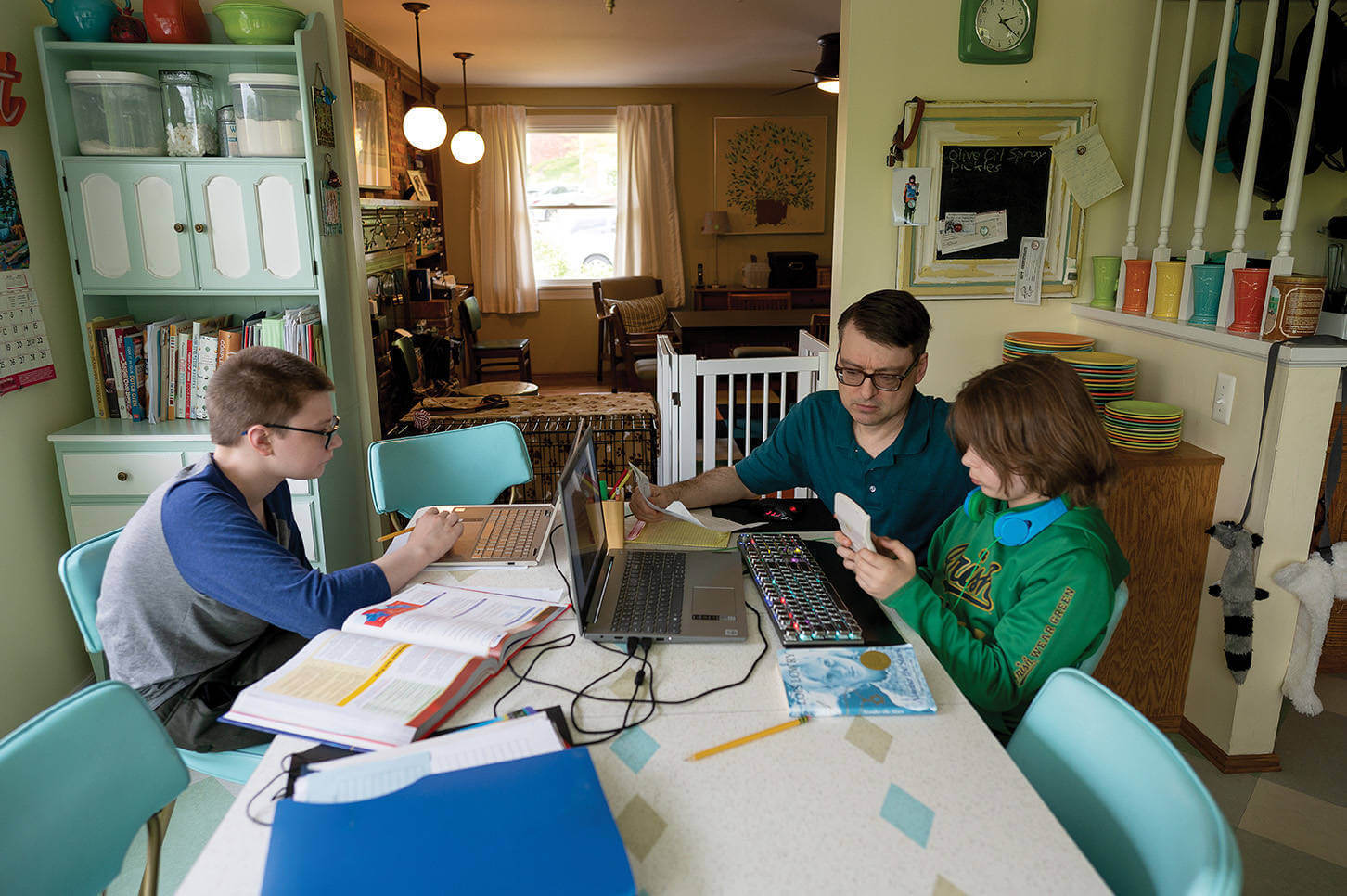
Common problems
The “right thing to do” has been a frequent topic of conversation in our house, too. When the pandemic began, I was pregnant with our second child and had a curious 1-year-old running around. With so little data on how the virus was affecting children, and with my own fear of delivering a baby while COVID-positive, I locked our house down. We had no playdates, no outings. We let our sitter go, and I opted to juggle motherhood and part-time freelancing while my husband maintained a demanding schedule as an Air Force pilot. I carried the constant, heavy burden that I was doing something wrong by sheltering both our babies. Even so, I was one of the lucky ones. I had the freedom to rework my schedule and taper my freelance work to fit the time I could allot without child care. Most women aren’t so fortunate.
According to the U.S. Census Bureau, in January 2020, nearly one-third of American mothers of school-age children — roughly 8.6 million women — were not in the paid workforce. The pandemic exacerbated things — an additional 1.4 million of these mothers were out of work a year later, and the rates of loss were more severe among minority and single mothers. In that time, a reported 700,000 American moms have given up on returning to work.
The pandemic also caused dips for men, but recovery has been much slower for women, with the current proportion of women in the workforce back at 1980s levels. The reasons for the gap are varied, but common explanations include that mothers are likelier to work in those service, health and education professions most severely impacted by the pandemic, and that mothers still perform the bulk of child care and domestic duties. Some surveys estimate that 40 percent of mothers have added upwards of 15 hours per week in caregiving and housekeeping over the past year and a half, while only 20 percent of men have done the same.
Ocobock says the dual-career couples in her study reported that the mother took the lead at home, even if the parents had comparable job demands. “We culturally position moms as children’s primary caretakers. Moms are the ones that are responsible for child care. This is the message we get from every sphere, so this is a deeply embedded, deeply ingrained cultural belief that moms are better suited to this task, that it comes more naturally to them, and that is their job,” she says. “That lets dads off the hook a little bit.”
The U.S. Census Bureau says one in five working-age adults who stopped working during the pandemic cited child care issues as the reason. Mothers were three times as likely to halt their work for that reason. That may be in part because the gender pay gap of 82 cents to the dollar renders many women’s jobs less lucrative than their partner’s. Or, as Ocobock notes, most women perceive their jobs as more flexible, less demanding and less stressful than their spouse’s, even if that’s not true. Fathers in her study typically stepped in to help with kids or chores only when they had explicit flexibility or necessity demanded it, like when the mother fell ill or hit a breaking point. Never, Ocobock says, did a father mention guilt as a motivation, even when mother after mother expressed overwhelming guilt about navigating the work-parenting balance.
“The big finding is that not a single father I interviewed ever mentioned anything like guilt,” she underscores.
Ocobock is quick to say that this finding doesn’t make dads malicious. Plenty of them are actively involved in parenting and housework. One Harvard University study found 68 percent of fathers are feeling closer with their kids, and Ocobock interviewed many who said working from home allowed them to be around more or have lunch with their children.
Many fathers have used the pandemic as a chance to renegotiate their role in the family. But they weren’t typically flexing schedules or sacrificing work or sleep or leisure at the same rates as mothers, so the overall responsibility was continuing to burn out the guilt-ridden moms. Still, even small changes can be gateways to long-term transformation.
Some fathers like Paul Perl ’94M.A., ’00Ph.D. were already the primary caregivers in their families. Perl has been a stay-at-home dad since he and his wife, Diana DiBerardino ’96M.S., ’98Ph.D., adopted their first son in 2006. Perl had just reentered the workforce when the pandemic hit, causing his kids, now 9 and 15, to shift to remote learning. He soon realized that at-home learning required hands-on parenting. He spent his days printing worksheets, explaining assignments and helping the kids jump from one technology platform to another.
“Especially for my younger son it was just too overwhelming for him to know what link he was supposed to get on,” he says. “There was no way he could get on it himself.”
Perl moved his part-time work to nights and weekends and turned down promotions in order to facilitate the e-learning. Now, as his children head back to school, he is again considering full-time work, but believes he needs to learn new software and coding skills before he can jump back into life as a sociologist.
“The field has somewhat passed me by while I’ve been a stay-at-home dad,” he says. “That’s a problem a lot of women face when they take significant time out of the workforce — it can be hard to get back in it. Now I’m sort of facing the same thing.”
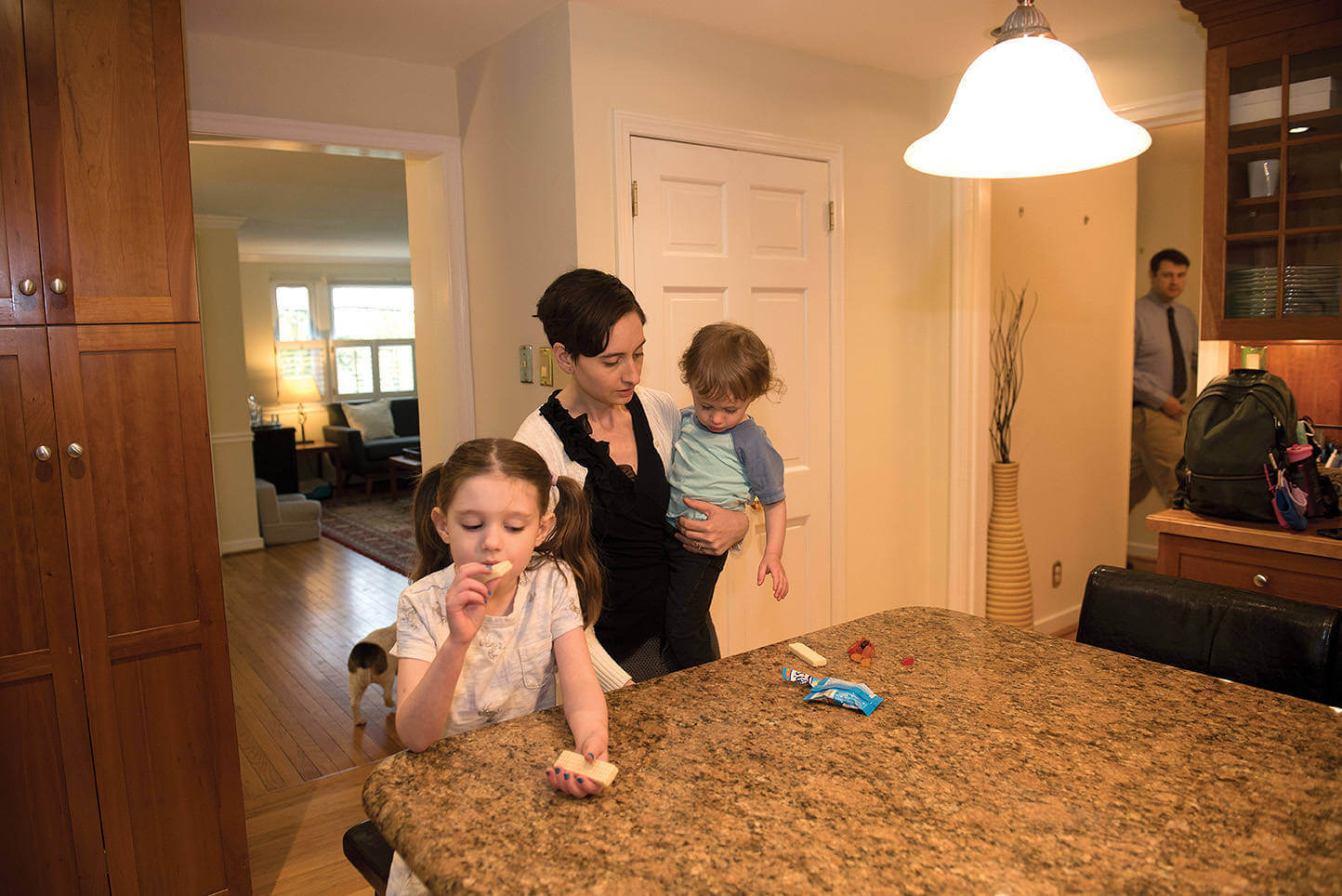
Long-term side effects
Things have improved slightly this year as infection rates declined, schools reopened and families learned to juggle child care and virtual schooling. And we could hypothesize that things will return to normal as the world recovers, but by then promotions, job changes and salary increases will have passed many of these mothers by, so the question remains: What long-term effects will the pandemic have on women in the workforce?
Career mobility aside, one alarming possibility is an increase in burnout and mental health issues. A recent study by LeanIn.org found that women are twice as likely as men to be experiencing symptoms of anxiety. Half of women, compared to a third of men, are having trouble sleeping.
Mary DeAgostino-Kelly ’09 can relate. A physician and assistant professor of obstetrics and gynecology at the University of Pennsylvania, she has a 6-year-old and a toddler, and her husband, Kevin, is a middle school teacher. Before COVID, he handled most of the day care shuttling, and her in-laws filled in any gaps while she zipped from the operating room to the office. But when COVID crept into her hospital, they cut ties from family to whom she feared she might unintentionally pass the virus.
“One of the biggest things that stands out to me is that it was just the first time in my life I had truly experienced anxiety. I’m not an anxious person at baseline, and it was really the first time I felt like things were . . . way out of control, and I didn’t know what to anticipate, how to plan for things. I was just very uncertain every day going to work if I was in danger, if I was putting my family in danger, if people were going to be dying at work that day, which always is a risk, but seemed like a higher risk.”
DeAgostino-Kelly was in her first year as an attending physician, so there was no way to dial back, even when the day care closed. Though elective surgeries and patient visits were reduced, she began doing telehealth visits from the family’s two-bedroom apartment on days she wasn’t at the hospital. Being home increased the guilt because she could hear the kids in the next room, and she could hear her husband trying to work while caring for them.
“He’s teaching from home with the 5-year-old on her Zoom class, so it put a lot of extra stress on him, and then a lot of guilt on me,” she says. “It’s definitely easier when we just could hire [child care] out, and then it’s not like we have to make value judgments on different people’s work and who needs to spend more time caring for the children, when technically both of us are on the clock,” she says.
She notes that as work-from-home and e-learning have dragged on, the difficulties have grown. Where her husband once might have called for a substitute teacher, that’s no longer really an option.
“There needed to be more flexibility, but it just wasn’t always there,” she says.
Societally, we have room for improvement. The LeanIn.org survey showed that only 18 percent of employees felt their company had reduced workload or expectations during the pandemic. Similarly, the consulting firm McKinsey & Company reported that of the 317 companies in its study, less than a third have changed their performance-review criteria or productivity requirements. The resulting burnout is affecting people across the board, but most prominently senior-level women.
Half of the companies McKinsey surveyed have increased paid leave for employees, and one-third have offered stipends to offset work-from-home expenses. Nationally, the latest stimulus package offered $1,400 per dependent and tax credits of as much as $3,600 per child. Still, the average cost of child care for an infant in the United States is $1,230 per month, according to the Center for American Progress, so that money is quickly spent. Only three states — Hawaii, Indiana and South Dakota — provide subsidies that cover the average cost of care. Systemic change and subsidies could liberate women from feeling compelled to juggle work and child care, presumably keeping them in the workforce and stimulating economic growth, but that reality seems far off.
A smaller but seemingly more attainable goal could be paid parental leave. According to the Bureau of Labor Statistics, only one-fifth of the labor force in private industry — and roughly 5 percent of low-wage workers — qualifies for paid leave after the birth of a child, and only three states require employers to provide it. In some cases, mothers are heading back to work mere days after giving birth, likely bearing a burden of guilt as they choose between a paycheck and being with their newborn.
Some companies have taken notice. In March, a group of more than 200 U.S. businesses asked Congress to implement a family leave policy, an idea central to President Joe Biden’s election campaign. The result would likely keep more mothers in the workforce, which would benefit the economy, but more importantly, according to research published in The Harvard Review of Psychiatry, it could drastically improve maternal and infant health in both the short and long term. The Family and Medical Insurance Leave Act, which would guarantee 12 weeks of leave paid up to 66 percent of a worker’s salary, has been introduced to Congress several times but has never received a vote. The provisions would still leave the U.S. behind more than 35 other nations that currently offer paid parental leave, but it would be a start.
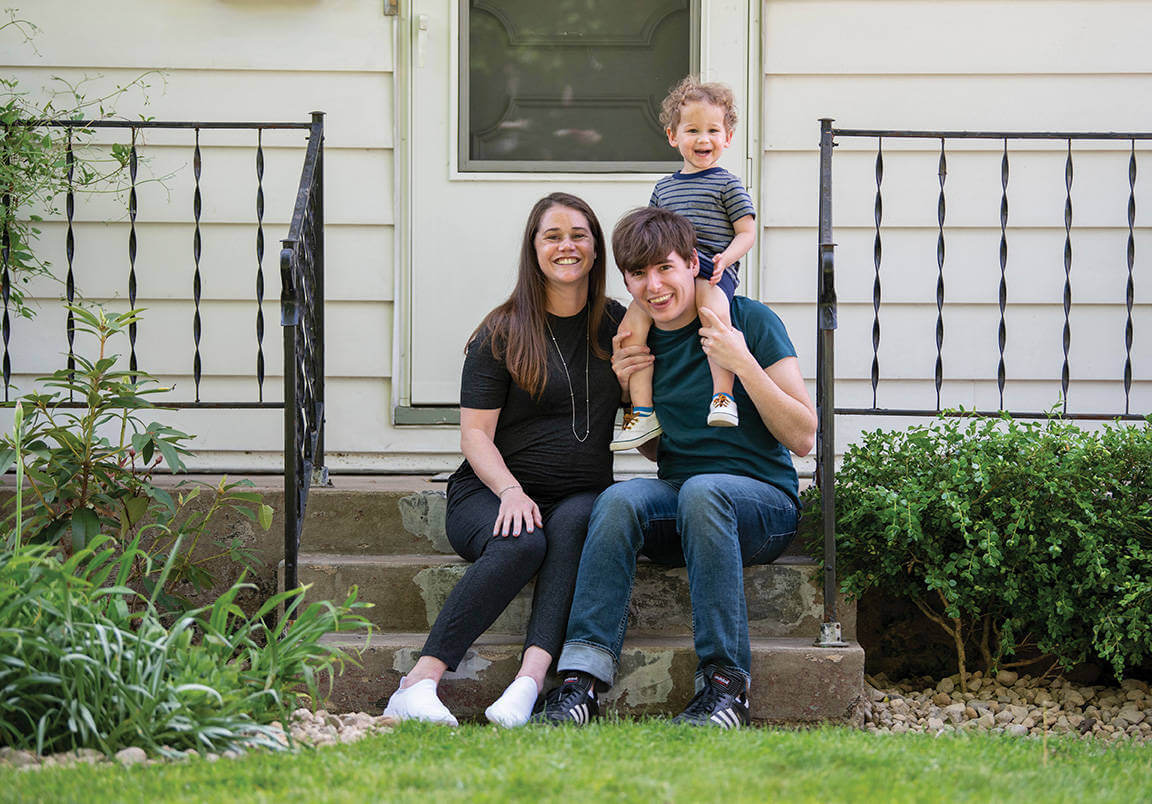
The bright side
The worst consequences of the pandemic — loss of life, lingering symptoms, derailed careers, economic decline — are grave and well documented, but there are some silver linings.
Families like the Palumbos believe the pandemic gave them the chance to be more present to each other and their children for a brief time — and an opportunity to reassess their priorities.
“The ability to see and be around for a lot of these milestones that we just didn’t expect to be around for, I wouldn’t trade that for anything,” Jenna Palumbo says.
At our house, we’ve embraced the outdoors and spent a lot of the past year exploring parks and beaches and farms we’d previously overlooked. The time indoors allowed me to pass my love of baking to my daughter through a weekly bake date.
It also forced me to examine why I chronically feel guilty, and whether the guilt is rooted in anything meaningful. Some of it is. I think until my little ones are grown I will feel a constant push-and-pull between wanting to be fully present to them and wanting to pursue professional ambitions, to have a regular chunk of time in which I’m me, not Mama.
For now, I’ve struck the right balance, but I still feel a twinge of guilt when I turn on the TV so I can take a work call. I also feel it when I’m baking cinnamon bread with my daughter in the middle of the day while most adults are working. That mothering-working wrestling match, and the pressure from proponents on both sides of that bout, undoubtedly contributes to the guilt complex. But I’m actively trying to tune that out and embrace the equilibrium of each moment.
Ocobock says cultural validation is another subtle contributor to mom guilt. Mothers often express guilt as a way of illustrating they are good moms, to prove they’re intently mothering and not phoning it in, she explains.
“I think guilt is something that moms genuinely feel, but I also think it’s something [they believe] that they’re supposed to feel,” she hypothesizes.
The insight rings true. It reminds me of my undergraduate years, when we would compare who slept least, discreetly competing to show who was working hardest to perfect a paper or study for an exam. In reality, there was likely little correlation between that lack of sleep and success. And there’s undoubtedly even less between guilt and good parenting, so why wear it as a badge of honor? Moms conveying guilt to other moms only perpetuates the idea that in order to be good parents, we must add activities to our calendars, home-cooked meals to our menus, hours to our days, even when it’s unnecessary and draining.
As I work on shedding my own mom guilt, I’m trying to give myself grace and remember that if I have personal balance, my family will, too. I’m also learning to embrace that some days we’ll eat healthy meals, read a stack of books and play outside, and some we’ll eat chicken nuggets and watch Frozen for the thousandth time. Both agendas can be part of our routine, and neither requires a serving of mom guilt.
Tara McMullen is a freelance writer and former associate editor of this magazine.